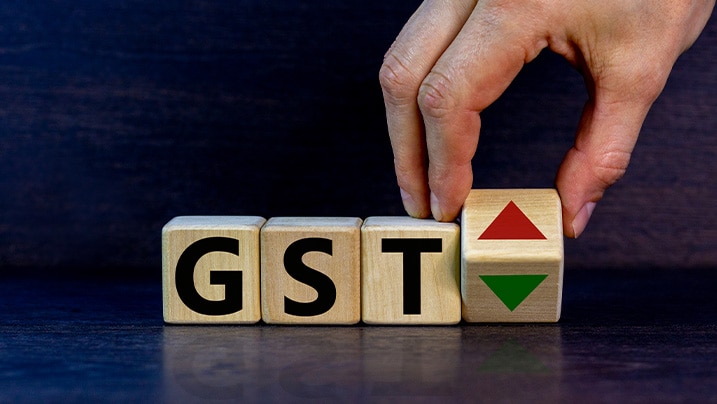CKYC Registry
-
Customer Service Contact us Service request Locate a branch
Find all the help you need
Scan the QR, get our app, and find help on your fingertips

Help CenterSupport topics, Contact us, FAQs and more
-
Login
Are you ready for an upgrade?
Login to the new experience with best features and services
-
Login
Are you ready for an upgrade?
Login to the new experience with best features and services
- Accounts
-
Deposits
IDFC FIRST Bank Deposits
View all Deposits -
Loans
IDFC FIRST Bank Loans
View all Loans - Wealth & Insure
-
Payments
IDFC FIRST Bank Payments
View all Payments -
Cards
IDFC FIRST Bank Cards
View all Cards - Blogs
- Corporate Account
-
Cash Management Services
IDFC FIRST Bank Cash Management Services
View all Cash Management Services - Supply Chain Finance
-
Corporate Lending
IDFC FIRST Bank Lending
View all -
Treasury
IDFC FIRST Bank Treasury
See more details - NBFC Financing
Support topics, Contact us, FAQs and more
- IDFC FIRST Bank Accounts
-
Savings Account
-
Corporate Salary
Account -
Senior Citizens
Savings Account -
First Power
Account -
Current Account
-
NRI Savings
Account -
TASC Institutional
Account -
Savings Account
Interest Calculator
- IDFC FIRST Bank Deposits
-
Fixed Deposit
-
Recurring Deposit
-
NRI Fixed Deposit
-
Safe Deposit Locker
-
FD Calculator
-
RD Calculator
- IDFC FIRST Bank Loans
-
Personal Loan
-
Consumer Durable
Loan -
Home Loan
-
Business Loan
-
Professional Loan
-
Education Loan
-
New Car Loan
-
Pre-owned Car Loan
-
Two Wheeler Loan
-
Pre-owned Two
Wheeler Loan -
Commercial Vehicle
Loan -
Gold Loan
-
Loan Against Property
-
Loan Against Securities
-
Easy Buy EMI card
-
Personal Loan
EMI Calculator -
Education Loan
EMI Calculator -
Home Loan
EMI Calculator -
EMI Calculator
-
Personal Loan Eligibility Calculator
- IDFC FIRST Bank Wealth & Insure
-
FIRST Select
-
FIRST Wealth
-
FIRST Private
-
Mutual Funds
-
Sovereign Gold Bond
-
Demat Account
-
Term Insurance
-
Life Insurance
-
Health Insurance
-
General Insurance
-
Bonds
-
Loan Against
Securities -
Portfolio Management
Service
- IDFC FIRST Bank Payments
-
FASTag
-
Credit Card
Bill Payments -
UPI
-
Funds Transfer
-
Forex Services
-
Pay Loan EMI
- IDFC FIRST Bank Cards
-
Ashva :
Metal Credit Card -
Mayura :
Metal Credit Card -
FIRST Millennia
Credit Card -
FIRST Classic
Credit Card -
FIRST Select
Credit Card -
FIRST Wealth
Credit Card -
FIRST WOW!
Credit Card -
Deals
-
Debit Cards
-
Co-branded Cards
-
Credit Card
EMI Calculator -
FIRST Corporate
Credit Card -
FIRST Purchase
Credit Card -
FIRST Business
Credit Card
- Premium Metal Credit Cards
-
AshvaLifestyle1% Forex₹2,999
-
MayuraLifestyleZero Forex₹5,999
-
FIRST PrivateInvite Only
- Best for travellers
-
MayuraZero ForexMetal₹5,999
-
Ashva1% ForexMetal₹2,999
-
FIRST WOW!Zero ForexTravelLifetime Free
-
FIRST SWYPTravel OffersEMI₹499
-
FIRST Select1.99% ForexLifestyleLifetime Free
-
FIRST Wealth1.5% ForexLifestyleLifetime Free
-
Club VistaraTravelLifestyle₹4,999
-
IndiGo IDFC FIRST Dual Credit CardTravelLifestyle₹4,999
- Max benefits, Free for life
-
FIRST Classic10X RewardsShoppingNever Expiring Rewards
-
FIRST Millennia10X RewardsShoppingNever Expiring Rewards
-
FIRST Select10X RewardsLifestyle1.99% Forex
-
FIRST Wealth10X RewardsLifestyle1.5% Forex
-
FIRST WOW!RewardsTravelZero Forex
-
LIC ClassicRewardsInsuranceShopping
-
LIC SelectRewardsInsuranceShopping
- Reward Multipliers
-
AshvaLifestyleMetal₹2,999
-
MayuraLifestyleZero Forex₹5,999
-
FIRST ClassicNever Expiring RewardsShoppingLifetime Free
-
FIRST MillenniaNever Expiring RewardsShoppingLifetime Free
-
FIRST SelectNever Expiring RewardsLifestyleLifetime Free
-
FIRST WealthNever Expiring RewardsLifestyleLifetime Free
- Rewards & Credit on UPI
-
FIRST Power+FuelUPI₹499
-
FIRST PowerFuelUPI₹199
-
FIRST EA₹NVirtual1% Cashback₹499
-
FIRST DigitalVirtualUPI₹199
-
IndiGo IDFC FIRST Dual Credit CardUPITravelDual cards
- Fuel and Savings
-
FIRST PowerRewardsUPI₹199
-
FIRST Power+RewardsUPI₹499
-
LIC ClassicRewardsInsuranceShopping
-
LIC SelectRewardsInsuranceShopping
- Express and Flaunt
-
AshvaMetal1% Forex₹2,999
-
MayuraMetalZero Forex₹5,999
-
FIRST SWYPEMIOfferMAX₹499
-
FIRST MillenniaRewardsShoppingLifetime Free
- FD Backed rewarding Credit Cards for all
-
FIRST EA₹NVirtualCashback₹499
-
FIRST WOW!Zero ForexTravelLifetime Free
-
CreditPro Balance TransferTransfer & SaveReduce InterestPay Smartly
- IDFC FIRST Bank NRI Forex Solutions
-
Send money to India-Wire transfer
-
Send money to India-Digitally
-
Send money abroad
-
Max Returns FD (INR)
- IDFC FIRST Bank MSME Accounts
-
Platinum Current
Account -
Gold
Current Account -
Silver Plus
Current Account -
Merchant Multiplier
Account -
Agri Multiplier
Account -
TASC Institutional
Account -
Dynamic Current
Account -
World business
Account -
First Startup
Current Account
- IDFC FIRST Bank Business Loans
-
Business Loan
-
Professional Loan
-
Loan Against Property
-
Business Loan for Women
-
Working Capital Loan
-
Construction Equipment Loan
-
Machinery Loan
-
Healthcare Equipment Loan
- IDFC FIRST Bank Business Solutions
-
Payment Solutions
-
Tax Payments
-
Doorstep Banking
-
Point of Sale (POS)
-
Escrow Accounts
-
NACH
-
Payment Gateway
-
UPI
-
Virtual Accounts
-
As per amendment in the Income Tax Rules, PAN or Aadhaar are to be mandatorily quoted for cash deposit or withdrawal aggregating to Rupees twenty lakhs or more in a FY. Please update your PAN or Aadhaar. Kindly reach out to the Bank’s contact center on 1800 10 888 or visit the nearest IDFC FIRST Bank branch for further queries.
-
-
Most Searched
Sorry!
We couldn’t find ‘’ in our website
Here is what you can do :
- Try checking the spelling and search
- Search from below suggestions instead
- Widen your search & try a more generic keyword
Suggested
Get a Credit Card
Enjoy Zero Charges on All Commonly Used Savings Account Services
Open Account Now
Reducing tax liability can help businesses strengthen their financial fundamentals and meet their revenue and profit targets
The GST (Goods and Service Tax) composition scheme offers small businesses two additional benefits compared to regular GST filing – less paperwork and lower tax liability. Any individual or entity eligible to register themself under the GST composition scheme must submit one quarterly return (GSTR 4) and one annual return (GSTR 9) as opposed to the quarterly GST returns that any other taxpayer files. Let us understand this scheme in more detail.
What are the rules of the GST composition scheme?
According to the GST Act, manufacturing businesses, service businesses, and traders can register under the GST composition scheme. However, the following individuals cannot register under the GST composition scheme.
- Any individual or business supplying goods through an e-commerce portal operator that collects tax at the source.
- Non-resident taxable persons or casual taxable persons.
- Ice cream manufacturers or manufacturers of other edible ice with or without cocoa as an additive.
- Manufacturers of pan masala and tobacco products and substitutes.
- Individuals or businesses who have purchased goods from unregistered suppliers.
- Suppliers involved in the supply of goods that are exempt under the GST Act.
- Suppliers, who supply goods and services.
READ MORE
Which features does the GST composition scheme have?
The GST composition scheme's features make it a preferable option for the following.
- Business owners registered under the GST composition scheme pay a relatively lower tax percentage than those registered under the regular GST scheme.
- The rates of the GST composition scheme differ based on the type of business. For example, a restaurant pays 5%, whereas manufacturers pay 1%.
- If a business owner has multiple businesses registered under a single PAN (Permanent Account Number), they must get all of them registered under the GST composition scheme. If the business owner does not wish to register all businesses under the GST composition scheme, they must opt out of the scheme.
- Any business owner registered under the GST composition scheme must file a single quarterly return by the 18th of the month following that quarter.
- While making a transaction under the reverse charge mechanism, a dealer must pay tax according to the general GST rate.
What is the composition limit under GST?
The GST composition limit differs for various businesses.
For manufacturers and traders
If you own a newly registered business, its turnover should not be more than ₹1.5 crores in the current financial year. If you have already registered, your business's turnover should not exceed ₹1.5 crores in the previous financial year.
Restaurants that do not serve alcohol
Restaurants that do not serve alcohol, too, can only register themselves under the GST composition scheme if their annual turnover exceeds ₹1.5 crores.
Service providers
For any newly registered business to be eligible for the GST composition scheme, its annual turnover should not exceed ₹50 lakh in the current financial year.
If a business has already been registered, its turnover should not exceed ₹50 crores in the previous financial year.
Manufacturers of goods, dealers, and restaurant owners who do not serve alcohol can avail themselves of the GST composition scheme.
Who is eligible to opt for the GST composition scheme?
The following individuals are eligible to opt for the GST composition scheme, provided their annual turnover falls within the specified limit of ₹1.5 crores.
- Shopkeepers
- Small manufacturing units
- Foodservice units
- Service sector units
- Truck operators
- Repair store owners
- Machine operators
- Artisans
- Fruit and vegetable vendors
What are the limits of the GST composition scheme?
Here are all the disadvantages of registering for the GST composition scheme.
No input tax credit
B2B businesses are not allowed the credit of input tax paid from the output liability. The buyer of such goods will not get any credit on tax paid, which would lead to price distortion and cascading. A buyer registered as a regular taxpayer will not get any credit while buying from a person registered under a composition scheme, resulting in a loss of business.
No tax collection
Under the composition scheme, taxpayers cannot recover composition tax from their buyers as they cannot raise a tax invoice.
Limited business reach
The GST composition scheme does not cover inter-state transactions. They also cannot leverage the potential of the internet as a supply of goods via e-commerce portals.
What are the benefits of the GST composition scheme?
Here are the benefits that eligible business owners can get from the GST composition scheme.
- Small business owners can benefit from a reduced tax liability after implementing the new tax structure.
- Taxpayers must adhere to lesser compliance in keeping records to pay their taxes and can sidestep the need to provide tax invoices.
- Reduced tax liability via the fixed rate exposes the business to higher liquidity. Higher liquidity, in turn, helps the business maintain its cash flow, which allows it to sustain operations smoothly.
You can use IDFC FIRST Bank's GST Compliance Manual to know more about the Goods and Service Tax and how to pay it.
Disclaimer
The contents of this article/infographic/picture/video are meant solely for information purposes. The contents are generic in nature and for informational purposes only. It is not a substitute for specific advice in your own circumstances. The information is subject to updation, completion, revision, verification and amendment and the same may change materially. The information is not intended for distribution or use by any person in any jurisdiction where such distribution or use would be contrary to law or regulation or would subject IDFC FIRST Bank or its affiliates to any licensing or registration requirements. IDFC FIRST Bank shall not be responsible for any direct/indirect loss or liability incurred by the reader for taking any financial decisions based on the contents and information mentioned. Please consult your financial advisor before making any financial decision.
The features, benefits and offers mentioned in the article are applicable as on the day of publication of this blog and is subject to change without notice. The contents herein are also subject to other product specific terms and conditions and any third party terms and conditions, as applicable. Please refer our website www.idfcfirstbank.com for latest updates.























